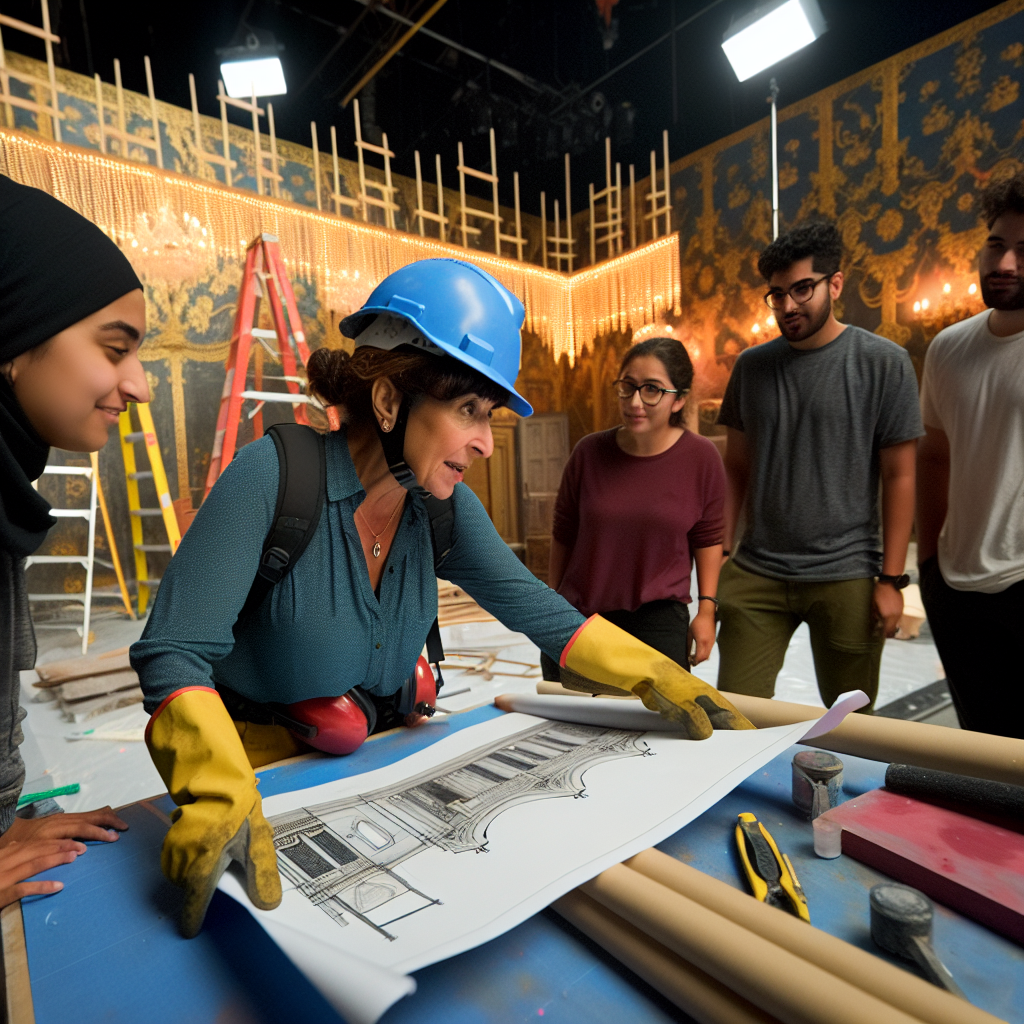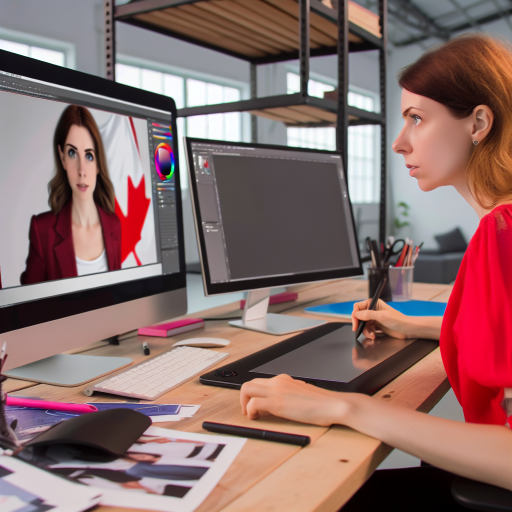Overview of Set Design in the Film Industry
Defining Set Design
Set design creates the visual environment for a film.
It involves crafting spaces that tell stories visually.
Set designers work closely with directors and producers.
Their role is integral to the film’s overall aesthetic.
The Importance of Set Design
Set design significantly impacts a film’s mood and tone.
It helps to immerse the audience in the narrative.
Each set contributes to character development and plot progression.
Collaboration in the Film Production Process
Set designers collaborate with various departments.
They work alongside art directors, costume designers, and cinematographers.
This teamwork ensures a cohesive visual presentation.
Skills Required for Set Designers
Creativity is the core skill for set designers.
They must envision and conceptualize immersive environments.
Attention to detail is also essential for creating realistic sets.
Strong communication skills help in collaborative settings.
Tools and Techniques
Set designers use various tools to create their designs.
Computer-aided design (CAD) software is commonly used.
This technology allows for detailed and accurate visualizations.
Pathways to a Career in Set Design
A degree in fine arts or theatre design is beneficial.
Many successful set designers also have backgrounds in architecture.
Gaining experience through internships or apprenticeships is crucial.
Networking plays a key role in finding job opportunities.
Educational Pathways: Relevant Degrees and Courses
Understanding the Importance of Education
A strong educational background serves as the foundation for a set designer’s career.
Education equips designers with essential skills and knowledge.
Furthermore, it opens doors to networking opportunities within the industry.
Degrees to Consider
Many aspiring set designers pursue a Bachelor’s degree in Fine Arts.
Unlock Your Career Potential
Visualize a clear path to success with our tailored Career Consulting service. Personalized insights in just 1-3 days.
Get StartedRelated fields include theater design, interior design, or visual arts.
These programs provide critical hands-on experience.
Additionally, students learn about design principles and color theory.
Specialized Courses
Many schools offer specialized courses in set design.
These courses often cover topics like production design and model making.
Other important subjects include stagecraft and lighting design.
Moreover, courses in digital design tools enhance a designer’s skill set.
Internships and Practical Experience
Internships play a vital role in gaining real-world experience.
A practical approach allows students to apply their classroom knowledge.
Furthermore, internships help build connections within the film industry.
Many interns receive valuable mentorship from experienced professionals.
Professional Certifications
Certification programs also contribute to a designer’s credentials.
Organizations such as the Canadian Institute for Theatre Technology offer valuable courses.
These programs often include advanced training in specific design software.
Thus, certifications enhance a designer’s employability in a competitive market.
Essential Skills Required for Set Designers
Creativity and Artistic Vision
Set designers must possess a strong creative flair.
They visualize concepts and ideas for film sets.
This artistic vision helps bring scripts to life.
Effective communication of ideas to the team is essential.
Designers often sketch their initial ideas and plans.
Technical Proficiency
Technical skills are crucial for set designers.
They should understand lighting, color theory, and materials.
Knowledge about construction techniques also benefits designers.
Familiarity with design software enhances their capabilities.
Collaboration and Teamwork
Collaboration is a key aspect of set design.
Designers work closely with directors and production teams.
Listening to feedback fosters a cohesive creative vision.
Building strong relationships helps in problem-solving.
Attention to Detail
Set designers must exhibit keen attention to detail.
Small details significantly impact the overall aesthetic.
They ensure every element aligns with the project’s vision.
A meticulous approach often enhances visual storytelling.
Time Management and Organization
Set designers frequently juggle multiple tasks.
Effective time management is essential to meet deadlines.
Organizational skills help manage budgets and resources.
Prioritizing tasks ensures the smooth progression of projects.
Adaptability and Problem-Solving
Set designers must adapt to changing scenarios.
Being flexible helps them adjust designs on the fly.
Problem-solving skills allow designers to overcome challenges.
Quick thinking contributes to maintaining project timelines.
Delve into the Subject: How Streaming Platforms Are Opening New Career Doors in Canada’s Film Industry
Building Experience: Internships and Entry-Level Positions
Exploring Internship Opportunities
Internships offer invaluable experience for aspiring set designers.
They provide a unique chance to learn from seasoned professionals.
Many film schools partner with production companies for internships.
These opportunities often lead to networking and job offers.
Entry-Level Positions in the Industry
Entry-level positions are vital for gaining hands-on experience.
Look for roles like production assistant or art department runner.
These positions introduce you to the dynamics of a film set.
Additionally, they allow you to collaborate with various departments.
Building a Portfolio
A strong portfolio showcases your design abilities effectively.
Include photographs of past projects and conceptual designs.
Ensure to highlight any collaborative work on film sets.
Your portfolio can be a crucial tool for job applications.
Networking and Industry Events
Networking plays a pivotal role in the film industry.
Attend film festivals, trade shows, and industry workshops.
Building relationships can lead to job referrals and mentorship.
Utilize social media platforms to connect with industry professionals.
Educational Pathways
Consider enrolling in vocational programs or courses in set design.
Many institutions offer specialized programs in film production.
These programs often include practical training and internships.
Furthermore, they teach essential software skills for modern design.
Joining Professional Organizations
Become a member of organizations like the Art Directors Guild.
Membership provides access to resources and industry updates.
Additionally, it can enhance your credibility as a designer.
Participating in workshops through these organizations enhances skills.
Discover More: The Rise of Digital Content Creation: New Career Paths in Canada’s Creative Industry
Networking Strategies in Canada’s Film Community
Building Relationships
Networking is essential for aspiring set designers in Canada.
Building relationships within the film industry opens doors to opportunities.
Start by attending local film festivals and networking events.
Such gatherings provide a chance to meet industry professionals.
Be proactive in introducing yourself to others.
Offer insights about your work and show genuine interest in theirs.
Utilizing Online Platforms
Online platforms are great tools for expanding your network.
Consider joining social media groups focused on film and set design.
LinkedIn is also a valuable resource for professional connections.
Engage with posts and share your achievements to increase visibility.
Online forums like Reddit also have communities dedicated to film production.
Leveraging Industry Events
Participating in workshops and seminars can enhance your skills.
These events often attract professionals from the film industry.
Don’t hesitate to initiate conversations with speakers and participants.
Follow up with them after the event via email or social media.
This helps to solidify connections and extends your network.
Joining Professional Organizations
Professional organizations can provide support and resources.
Look for groups like the Canadian Society of Cinematographers.
Membership often comes with access to networking events and workshops.
Such organizations can also offer mentorship opportunities.
Networking Etiquette
Practicing good networking etiquette is crucial.
Always be respectful of others’ time and space during events.
When following up, personalize your message and remind them of your conversation.
Offer assistance or collaboration to build stronger connections.
Remember, networking is about mutual benefit and support.
Find Out More: Exploring the Growth of Film Directing in Canada’s Cultural Scene

Tools and Software Used in Set Design
Essential Tools for Set Designers
Set designers rely on a variety of tools for their projects.
Hand tools include saws, hammers, and measuring devices.
These tools are vital for constructing physical sets.
Additionally, designers use power tools for efficiency.
Tools like drills and nail guns save significant time.
Software for Digital Design
Digital software plays a crucial role in modern set design.
Programs like AutoCAD allow designers to create detailed plans.
SketchUp offers an intuitive 3D modeling environment.
These software tools enhance visualization and collaboration.
Collaboration and Project Management Tools
Effective communication is key in the film industry.
Set designers often use platforms like Trello and Asana.
These tools help track progress and manage tasks efficiently.
File-sharing services like Google Drive facilitate document sharing.
Lighting and Rendering Software
Lighting is critical in set design for creating mood.
Software like Adobe After Effects helps in rendering lighting effects.
Additionally, virtual reality tools allow for immersive experiences.
Such technologies help set designers visualize their ideas better.
Networking and Education Software
Online platforms enhance networking opportunities for set designers.
LinkedIn allows professionals to connect and share experiences.
Design schools often use Learning Management Systems.
These systems facilitate collaboration among students and instructors.
Find Out More: Breaking Into Canada’s Creative Industries: Top Careers
The Role of a Set Designer During Film Production
Creative Vision and Concept Development
A set designer brings the script’s vision to life through visual storytelling.
They collaborate closely with directors and producers to understand the narrative.
This process involves thorough research on settings relevant to the story.
Their creativity helps shape the universe in which characters exist.
Collaboration with Various Departments
Set designers work alongside art directors, costume designers, and lighting teams.
This collaboration ensures a harmonious visual aesthetic throughout the film.
Clear communication is vital to adapting designs based on production needs.
They may also consult with special effects teams for integrated designs.
Material Selection and Resource Management
Choosing the right materials is a crucial task for set designers.
They consider durability, aesthetics, and budget constraints when selecting resources.
Understanding construction techniques allows for effective set building.
Additionally, they may repurpose materials to maintain sustainability in production.
Set Construction and Installation
Once designs are finalized, set designers oversee the construction phase.
They manage crews of skilled artisans and laborers during set building.
Throughout this stage, attention to detail ensures each element aligns with the vision.
The installation phase also involves measuring and adjusting layouts for camera angles.
On-Set Adjustments and Problem Solving
During filming, set designers must be adaptable and proactive.
They monitor the set for any needed adjustments based on filming requirements.
This flexibility allows the production to maintain its pace and efficiency.
Set designers often troubleshoot issues without disrupting the filming process.
Post-Production Involvement
After filming, set designers may assist in breaking down and documenting sets.
They evaluate what worked well and what can improve future projects.
This reflection fosters growth and enhances their future design strategies.
Additionally, they may contribute to promotional materials featuring the sets.
Career Advancement Opportunities for Set Designers
Networking and Industry Connections
Networking plays a crucial role in advancing a set designer’s career.
Building relationships with industry professionals opens doors to new projects.
Participating in film festivals helps to showcase your work and talent.
Joining local film and art groups can provide opportunities for collaboration.
Consider attending workshops to learn from experienced set designers.
Use social media platforms to connect and engage with peers in the industry.
Continuing Education and Training
Ongoing education helps refine skills and explore new design techniques.
Look for courses that focus on set design, art direction, and related fields.
Online resources and platforms provide flexibility for learning at your own pace.
Many universities offer certificate programs specifically for set design.
Stay updated with the latest trends and technologies in film production.
Seeking Diverse Opportunities
Work in various film genres to broaden your experience and portfolio.
Consider opportunities in theatre or television to diversify your skills.
Freelancing can provide flexibility and varied projects to enhance your resume.
Volunteer for student films or indie projects to gain practical experience.
Engage with creative agencies that offer set design for commercial shoots.
Professional Development and Certifications
Certifications can bolster your credibility in the competitive film industry.
Look for training programs offered by industry associations.
Specializing in sustainable set design can set you apart in the job market.
Attend seminars that highlight the latest technologies in set design.
Develop a personal brand that reflects your unique design style.
Additional Resources
7 Best Interior Design Schools in Canada in 2024 – Yorkville




